Myanmar
Myanmar became a full member of SASEC in February 2017, following several years as an active observer. Bangladesh, Bhutan, India, and Nepal formed the project-based partnership in 2001. Maldives and Sri Lanka joined SASEC in May 2014.
Myanmar's National Comprehensive Development Plan (NDCP) A Prosperous Nation Integrated Into the Global Community 2030 envisions a prosperous country integrated into the global community, supported by strategic thrusts in economic development, environmental protection, and the strengthening of governance and public institutions. In view of the changing global and regional economy, Myanmar intends to focus on integration into the global economic system, emphasizing institutional and policy changes, and implementing sectoral and regional strategies.
SASEC Technical Assistance in Myanmar
ADB-financed technical assistance has supported SASEC activities in Myanmar to help advance the country’s engagement in regional cooperation activities, including under the Bay of Bengal Initiative for Multi-Sectoral Technical and Economic Cooperation (BIMSTEC) framework. Myanmar has actively participated—first as observer, and then as full member—in SASEC regional technical assistance projects that have supported regional cooperation forums, knowledge-sharing initiatives, and capacity building.
Trade Snapshot
Direction of Intraregional Trade
The value of Myanmar's merchandise exports and imports trade with other SASEC countries, using International Monetary Fund data from 2025, is captured in the tables below.
Myanmar's largest import source in the SASEC subregion is India, with imports at $359 million. Its 2nd largest import source is Bangladesh, with imports valued at $23 million.
In the SASEC subregion, India is Myanmar's largest export destination, with exports valued at about $1.3 billion, followed by Bangladesh, with exports from Myanmar at $67 million. Nepal is Myanmar's 3rd largest market, with exports at $4 million.
Myanmar Trade - Import
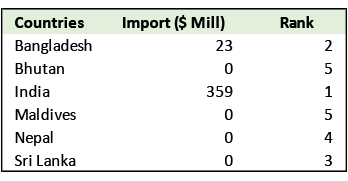 Source: IMF Direction of Trade Statistics via ARIC Database, accessed June 2025
Source: IMF Direction of Trade Statistics via ARIC Database, accessed June 2025
Myanmar Trade - Export
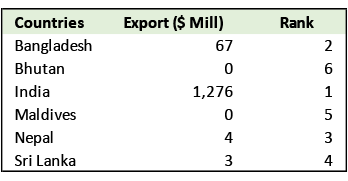 Source: IMF Direction of Trade Statistics via ARIC Database, accessed June 2025
Source: IMF Direction of Trade Statistics via ARIC Database, accessed June 2025
Logistics Performance Index (LPI)
Myanmar's overall LPI score for 2018 is 2.3. The country saw an improved score in timeliness (2.91 from 2.85) and a dip in its scores in the five other categories. It scored 2.28 in logistics competence and 2.20 in both international shipments and tracking and tracing. In 2018, Myanmar ranked 137 out of 168 economies.
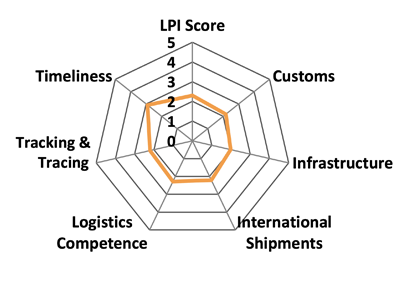
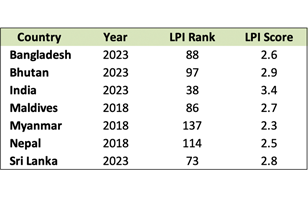

Source: World Bank LPI (accessed May 2023)
Note: The LPI overall score reflects perceptions of a country's logistics based on six core dimensions: (i) efficiency of customs clearance process, (ii) quality of trade- and transport-related infrastructure, (iii) ease of arranging competitively priced shipments, (iv) quality of logistics services, (v) ability to track and trace consignments, and (vi) frequency with which shipments reach the consignee within the scheduled time. The scores for the six areas are averaged across all respondents and aggregated to a single score using principal components analysis. A higher score indicates better performance.
Economic Outlook
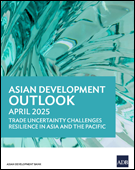
Myanmar will experience modest gross domestic product (GDP) growth of 1.1% in fiscal year (FY) 2025 and 1.6% in FY2026, premised on growth in industry and services. Headline inflation is forecast at 29.3% in FY2025 and 20.0% in FY2026, partly as a consequence of disruptions in food production.
Source: Asian Development Outlook, April 2025 (ADB)
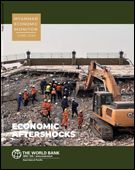
A 2.5% contraction is projected for Myanmar’s real GDP in FY2025-2026, due to the impact on production from the March 2025 earthquake. Growth will recover to 3.0% in FY2026-2027 with a projected recovery in trade, logistics, construction, manufacturing, and other key sectors.
Source: Myanmar Economic Monitor, June 2025 (WB)

